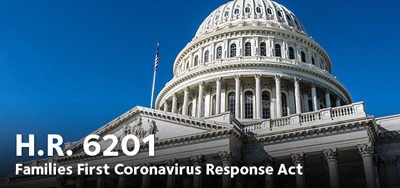
DIVISION C—EMERGENCY FAMILY AND MEDICAL LEAVE EXPANSION ACT
SEC. 3101. SHORT TITLE.
This Act may be cited as ‘‘Emergency Family and Medical Leave Expansion Act’’.
SEC. 3102. AMENDMENTS TO THE FAMILY AND MEDICAL LEAVE ACT OF 1993.
(a) PUBLIC HEALTH EMERGENCY LEAVE.—
(1) IN GENERAL.—Section 102(a)(1) of the Family and Medical Leave Act of 1993 (29 U.S.C. 2612(a)(1)) is amended by adding at the end the following:
(F) During the period beginning on the date the Emergency Family and Medical Leave Expansion Act takes effect, and ending on December 31, 2020, because of a qualifying need related to a public health emergency in accordance with section 110.
(2) PAID LEAVE REQUIREMENT.—Section 102(c) of the Family and Medical Leave Act of 1993 (29 U.S.C. 2612(c)) is amended by striking ‘‘under subsection (a)’’ and inserting ‘‘under subsection (a) (other than certain periods of leave under subsection(a)(1)(F))’’.
(b) REQUIREMENTS.—Title I of the Family and Medical Leave Act of 1993 (29 U.S.C. 2611 et seq.) is amended by adding at the end the following:
SEC. 110. PUBLIC HEALTH EMERGENCY LEAVE.
(a) DEFINITIONS.—The following shall apply with respect to leave under section 102(a)(1)(F):
(1) APPLICATION OF CERTAIN TERMS.—The definitions in section 101 shall apply, except as follows:
(A) ELIGIBLE EMPLOYEE.—In lieu of the definition in sections 101(2)(A) and 101(2)(B)(ii), the term ‘eligible employee’ means an employee who has been employed for at least 30 calendar days by the employer with respect to whom leave is requested under section 102(a)(1)(F).
(B) EMPLOYER THRESHOLD.—Section 101(4)(A)(i) shall be applied by substituting ‘fewer than 500 employees’ for ‘50 or more employees for each working day during each of 20 or more calendar workweeks in the current or preceding calendar year’.
(2) ADDITIONAL DEFINITIONS.—In addition to the definitions described in paragraph (1), the following definitions shall apply with respect to leave under section 102(a)(1)(F):
(A) QUALIFYING NEED RELATED TO A PUBLIC HEALTH EMERGENCY.—The term ‘qualifying need related to a public health emergency’, with respect to leave, means the employee is unable to work (or telework) due to a need for leave to care for the son or daughter under 18 years of age of such employee if the school or place of care has been closed, or the child care provider of such son or daughter is unavailable, due to a public health emergency.
(B) PUBLIC HEALTH EMERGENCY.—The term ‘public health emergency’ means an emergency with respect to COVID–19 declared by a Federal, State, or local authority.
(C) CHILD CARE PROVIDER.—The term ‘child care provider’ means a provider who receives compensation for providing child care services on a regular basis, including an ‘eligible child care provider’ (as defined in section 658P of the Child Care and Development Block Grant Act of 1990 (42 U.S.C. 9858n)).
(D) SCHOOL.—The term ‘school’ means an ‘elementary school’ or ‘secondary school’ as such terms are defined in section 8101 of the Elementary and Secondary Education Act of 1965 (20 U.S.C. 7801).
(3) REGULATORY AUTHORITIES.—The Secretary of Labor shall have the authority to issue regulations for good cause under sections 553(b)(B) and 553(d)(A) of title 5, United States Code—
(A) to exclude certain health care providers and emergency responders from the definition of eligible employee under section 110(a)(1)(A); and
(B) to exempt small businesses with fewer than 50 employees from the requirements of section 102(a)(1)(F) when the imposition of such requirements would jeopardize the viability of the business as a going concern.
(b) RELATIONSHIP TO PAID LEAVE.—
(1) UNPAID LEAVE FOR INITIAL 10 DAYS.—
(A) IN GENERAL.—The first 10 days for which an employee takes leave under section 102(a)(1)(F) may consist of unpaid leave.
(B) EMPLOYEE ELECTION.—An employee may elect to substitute any accrued vacation leave, personal leave, or medical or sick leave for unpaid leave under section 102(a)(1)(F) in accordance with section 102(d)(2)(B).
(2) PAID LEAVE FOR SUBSEQUENT DAYS.—
(A) IN GENERAL.—An employer shall provide paid leave for each day of leave under section 102(a)(1)(F) that an employee takes after taking leave under such section for 10 days.
(B) CALCULATION.—
(i) IN GENERAL.—Subject to clause (ii), paid leave under subparagraph (A) for an employee shall be calculated based on—
(I) an amount that is not less than two-thirds of an employee’s regular rate of pay (as determined under section 7(e) of the Fair Labor Standards Act of 1938 (29 U.S.C. 207(e)); and
(II) the number of hours the employee would otherwise be normally scheduled to work (or the number of hours calculated under subparagraph (C)).
(ii) CLARIFICATION.—In no event shall such paid leave exceed $200 per day and $10,000 in the aggregate.
(C) VARYING SCHEDULE HOURS CALCULATION.—In the case of an employee whose schedule varies from week to week to such an extent that an employer is unable to determine with certainty the number of hours the employee would have worked if such employee had not taken leave under section 102(a)(1)(F), the employer shall use the following in place of such number:
(i) Subject to clause (ii), a number equal to the average number of hours that the employee was scheduled per day over the 6-month period ending on the date on which the employee takes such leave, including hours for which the employee took leave of any type.
(ii) If the employee did not work over such period, the reasonable expectation of the employee at the time of hiring of the average number of hours per day that the employee would normally be scheduled to work.
(c) NOTICE.—In any case where the necessity for leave under section 102(a)(1)(F) for the purpose described in subsection (a)(2)(A)(iii) is foreseeable, an employee shall provide the employer with such notice of leave as is practicable.
(d) RESTORATION TO POSITION.—
(1) IN GENERAL.—Section 104(a)(1) shall not apply with respect to an employee of an employer who employs fewer than 25 employees if the conditions described in paragraph (2) are met.
(2) CONDITIONS.—The conditions described in this paragraph are the following:
(A) The employee takes leave under section 102(a)(1)(F).
(B) The position held by the employee when the leave commenced does not exist due to economic conditions or other changes in operating conditions of the employer—
(i) that affect employment; and
(ii) are caused by a public health emergency during the period of leave.
(C) The employer makes reasonable efforts to restore the employee to a position equivalent to the position the employee held when the leave commenced, with equivalent employment benefits, pay, and other terms and conditions of employment.
(D) If the reasonable efforts of the employer under subparagraph (C) fail, the employer makes reasonable efforts during the period described in paragraph (3) to contact the employee if an equivalent position described in subparagraph (C) becomes available.
(3) CONTACT PERIOD.—The period described under this paragraph is the 1-year period beginning on the earlier of—
(A) the date on which the qualifying need related to a public health emergency concludes; or
(B) the date that is 12 weeks after the date on which the employee’s leave under section 102(a)(1)(F) commences.
SEC. 3103. EMPLOYMENT UNDER MULTI-EMPLOYER BARGAINING AGREEMENTS.
(a) EMPLOYERS.—An employer signatory to a multiemployer collective bargaining agreement may, consistent with its bargaining obligations and its collective bargaining agreement, fulfill its obligations under section 110(b)(2) of title I of the Family and Medical Leave Act of 1993, as added by the Families First Coronavirus Response Act, by making contributions to a multiemployer fund, plan, or program based on the paid leave each of its employees is entitled to under such section while working under the multiemployer collective bargaining agreement, provided that the fund, plan, or program enables employees to secure pay from such fund, plan, or program based on hours they have worked under the multiemployer collective bargaining agreement for paid leave taken under section 102(a)(1)(F) of title I of the Family and Medical Leave Act of 1993, as added by the Families First Coronavirus Response Act.
(b) EMPLOYEES.—Employees who work under a multiemployer collective bargaining agreement into which their employers make contributions as provided in subsection (a) may secure pay from such fund, plan, or program based on hours they have worked under the multiemployer collective bargaining agreement for paid leave taken under section 102(a)(1)(F) of title I of the Family and Medical Leave Act of 1993, as added by the Families First Coronavirus Response Act.
SEC. 3104. SPECIAL RULE FOR CERTAIN EMPLOYERS.
An employer under 110(a)(B) shall not be subject to section 107(a) for a violation of section 102(a)(1)(F) if the employer does not meet the definition of employer set forth in Section 101(4)(A)(i).
SEC. 3105. SPECIAL RULE FOR HEALTH CARE PROVIDERS AND EMERGENCY
RESPONDERS.
An employer of an employee who is a health care provider or an emergency responder may elect to exclude such employee from the application of the provisions in the amendments made under of section 3102 of this Act.
SEC. 3106. EFFECTIVE DATE.
This Act shall take effect not later than 15 days after the date of enactment of this Act.


